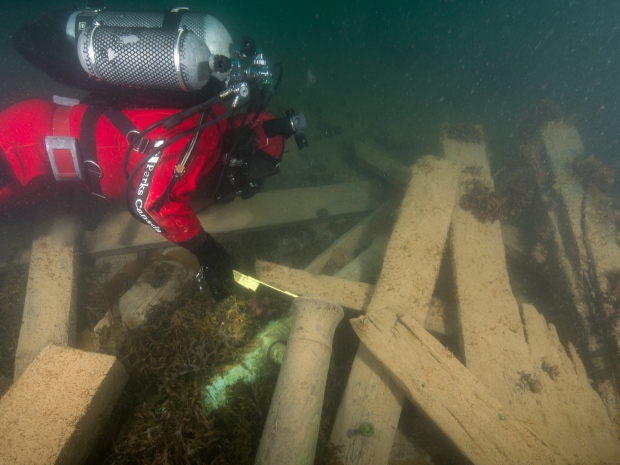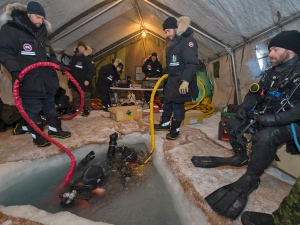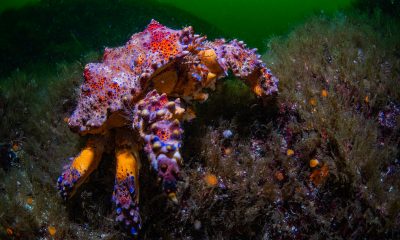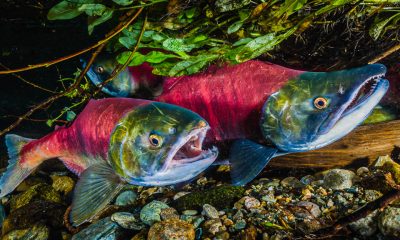News
Canadian search team consider ‘winter dive’ to explore Erebus wreck

Could the wreck of the HMS Erebus reveal the fate of Franklin himself?
A Canadian search team who found one of the lost vessels of the ill-fated Franklin expedition are so eager to get back to their discovery they are considering a dive through the Arctic ice in the spring to get a closer look at the well-preserved wreck of HMS Erebus.
“We’re exploring that possibility as we’re very anxious to get back,” said Ryan Harris, a senior underwater archeologist for Parks Canada.
Searchers discovered British explorer Sir John Franklin’s reinforced 19th-century wooden warship in the Queen Maud Gulf back in September.

HMS Erebus and HMS Terror, shown in the Illustrated London News published on May 24, 1845, left England that year under the command of Sir John Franklin and in the search of the Northwest Passage.
But winter was rapidly closing in across Nunavut, and after just 12 hours taking photos and video of the sunken British vessel, underwater archeologists had to pack up and sail out of the Arctic before freeze-up.
The search team has every intention of going back to the site next summer — along with continuing the quest to find the other lost Franklin expedition ship, the HMS Terror.
But if there’s a way to get back to Erebus sooner — and Harris certainly hopes there is — divers could be going through the ice next April in an attempt to unravel more of the mystery of what exactly happened to Franklin and his crew of 128 men as they tried to find the long-sought Northwest Passage.
“It’s not something we routinely do,” Harris says of what would be considered winter diving.
- Lost Franklin expedition ship found in the Arctic
- Franklin expedition ship found in Arctic ID’s as HMS Erebus
- Franklin ship discovery ‘just the beginning’
“It’s not particularly complex, but it would mean that we’d be diving with surface-supplied diving equipment, not scuba, for safety.”
They would also have to set up an ice camp and rely more on air support — whether it’s helicopters or Twin Otters. And the Parks Canada team would likely be working more closely with divers from the Royal Canadian Navy.
Lots of expertise
While winter diving to explore a shipwreck is rare, it’s not unprecedented.
Last spring, Jonathan Moore, one of the members of the Franklin search team, worked with the Navy at the Nunavut wreck site of the HMS Breadalbane.

Canadian Armed Forces divers working on the sea ice near Gascoyne Inlet, Nunavut, spent six days in April 2014 using remotely operated underwater vehicles to capture footage from the merchant ship Breadalbane, which sank in the High Arctic in 1853.
HMS Breadalbane sank near Beechey Island in 1853 while trying to get supplies to others looking for Franklin’s lost expedition.
“The ice camp was set up by the navy, and their fleet diving unit deployed a remotely operated vehicle to get images and data on the Breadalbane at a depth of 90 metres, quite a challenging wreck site to work on, so yes, there’s definitely precedent,” Harris said.
“There’s certainly a lot going on in the Canadian Arctic, and we have a lot of expertise that we can tap into.”
One of the questions now is whether that technical expertise can tap into the kind of private-public sector partnership that helped find the Franklin ships.
“I’ll be in a listening mode and a position to offer help, but I think this is exciting for Parks Canada because they are really going to be able to build off navy capacity in this case,” says Jim Balsillie, the co-founder and former chairman of BlackBerry-maker Research in Motion who was heavily involved in the Franklin search.
Balsillie helped start the Arctic Research Foundation, which refitted a fishing boat now known as the Martin Bergmann research vessel, which assisted in the search.
- Franklin find proves ‘Inuit oral history is strong’
- The Franklin search: Peter Mansbridge on why we should care
- 4 reasons why the Franklin discovery is important
Whether or how the foundation might support a winter dive hasn’t been determined, but Balsillie says he is ready for suggestions.
“We will respond to Parks’ lead and the navy’s request in any way, shape or form we can be of help,” says Balsillie, who considers the foundation’s involvement in the Franklin search a “multi-year, probably multi-decade” project.
Done responsibly
Harris also sees the exploration of the Erebus wreck as a multi-year project, and one that must be done responsibly and systematically.
“There’s still quite a bit of work to do there,” he says.
“What makes it kind of difficult is the wreck is covered with a blanket of kelp.
“You have to be there firsthand to be able to poke in under the kelp fronds that cover the upper deck to be able to identify some features.”
Still, what Harris has been able to see so far has left him spellbound by the potential to unravel some of the many questions that have hung over the ill-fated Franklin expedition since the mid-1800s.
“Every dive we made was just a discovery from beginning to end, and you could scarcely take it all in. Everywhere you looked there was something new and really quite remarkable.”
Now, underwater archeologists are reviewing the hundreds of photographs and a couple hours of video they were able to take in September.
They are carefully plotting and planning their next moves in investigating what Harris describes as a “rather complex structure” that is overall “quite remarkably well-preserved.”
One of the challenges is to determine how divers can get inside the wreck.

John Geiger, president of the Royal Canadian Geographical Society, holds an iron fitting called a davit from a Royal Navy ship, the key piece of evidence that led to the discovery of HMS Erebus in Queen Maud Gulf.
“A couple of us had the opportunity to drop down between the exposed deck beams and have a look around, but we weren’t penetrating below the decks at all.
“We were just kind of having a look and that tells us there’s a lot of room inside the forward half of the ship,” says Harris.
“You could look forward and see the ship’s galley stove. You could see the forward hatchway going down into the hold.”
Among the questions, could Erebus reveal anything further about the fate of Franklin himself?
“You don’t know at this point. The potential is almost limitless,” says Harris, noting that preservation conditions on an Arctic shipwreck can be “astoundingly favourable to the survival of organic materials, even including paper.”
Maybe there will be journals from crewmen, with handwritten accounts sealed up tight in a satchel.
Will there be human remains? (None have been spotted so far.)
Will there be anything that helps settle the questions around whether lead poisoning or botulism played a significant role in the sad demise of Franklin’s men?

Searchers wonder what clues HMS Erebus might offer around the fate of Sir John Franklin, who was at the helm of HMS Erebus when it left England in 1845 with HMS Terror amid great optimism that they could find the Northwest Passage and sail to China.
Will there be clues that reveal whether Erebus drifted on its own to where it was found, or whether it had been re-manned, after the ships that had been beset by ice for two years and abandoned in 1848 off King William Island?
Maybe there will be evidence that reveals what the men were trying to do if they did indeed re-man the ship and navigate it into the Queen Maud Gulf.
“Were they just trying to get closer to the mainland so they could proceed on foot? Did they still hold out a forlorn hope of one day navigating to the Beaufort Sea?” Harris wonders.
“Hopefully time will tell.”
Source: www.cbc.ca
Blogs
Northern Red Sea Reefs and Wrecks Trip Report, Part 3: The Mighty Thistlegorm

Jake Davies boards Ghazala Explorer for an unforgettable Red Sea diving experience…
Overnight, the wind picked up, making the planned morning dive a bit bumpy on the Zodiacs to the drop point on Thomas Reef. There, we would dive along the reef before descending through the canyon and then passing under the arch before ascending the wall with a gentle drift. The site provided great encounters with more pelagic species, including shoals of large barracuda, tuna, and bigeye trevally.
Once back on the boat, it was time to get everything tied down again as we would head back south. This time, with the wind behind us, heading to Ras Mohammed to dive Jackfish Alley for another great gentle drift wall dive before then heading up the coast towards the Gulf of Suez to moor up at the wreck of the Thistlegorm. This being the highlight wreck dive of the trip and for many onboard, including myself, it was the first time diving this iconic wreck. I had heard so much about the wreck from friends, and globally, this is a must on any diver’s list. Fortunately for us, there was only one other boat at the site, which was a rarity. A great briefing was delivered by Ahmed, who provided a detailed background about the wreck’s history along with all the required safety information as the currents and visibility at the site can be variable.

Kitting up, there was a lot of excitement on deck before entering the water and heading down the shoreline. Descending to the wreck, there was a light northerly current which reduced the visibility, making it feel more like the conditions that can be found off the Welsh coast. At 10m from the bottom, the outline of the wreck appeared as we reached the area of the wreck which had been bombed, as our mooring line was attached to part of the propeller shaft. Arriving on deck, instantly everywhere you looked there were many of the supplies which the ship was carrying, including Bren Carrier tanks and projectiles that instantly stood out.

We headed around the exterior, taking a look at the large propeller and guns mounted on deck before entering the wreck on the port side to take a look in the holds. It was incredible to see all the trucks, Norton 16H, and BSA motorcycles still perfectly stacked within, providing a real snapshot in time.

Overall, we had four dives on the Thistlegorm, where for all of the dives we were the only group in the water, and at times, there were just three of us on the whole wreck, which made it even more special, especially knowing that most days the wreck has hundreds of divers. Along with the history of the wreck, there was plenty of marine life on the wreck and around, from big green turtles to batfish, along with shoals of mackerel being hunted by trevally. Some unforgettable dives.

The final leg of the trip saw us cross back over the Suez Canal to the Gobal Islands where we planned to stay the night and do three dives at the Dolphin House for the potential of sharing the dive with dolphins. The site, which included a channel that was teeming with reef fish, especially large numbers of goatfish that swam in large shoals along the edge of the reef. These were nice relaxing dives to end the week. Unfortunately, the dolphins didn’t show up, which was okay as like all marine life they are difficult to predict and you can’t guarantee what’s going to be seen. With the last dive complete, we headed back to port for the final night where it was time to clean all the kit and pack before the departure flight the next day.

The whole week from start to finish on Ghazala Explorer was amazing; the boat had all the facilities you need for a comfortable week aboard. The crew were always there to help throughout the day and the chefs providing top quality food which was required after every dive. The itinerary providing some of the best diving with a nice mixture of wreck and reef dives. I would recommend the trip to anyone, whether it’s your first Red Sea liveaboard in the Red Sea or you’re revisiting. Hopefully, it’s not too long before I head back to explore more of the Red Sea onboard Ghazala Explorer.

To find out more about the Northern Red Sea reef and wrecks itineraries aboard Ghazala Explorer, or to book, contact Scuba Travel now:
Email: dive@scubatravel.com
Tel: +44 (0)1483 411590
Photos: Jake Davies / Avalon.Red
Blogs
Northern Red Sea Reefs and Wrecks Trip Report, Part 2: Wall to Wall Wrecks

Jake Davies boards Ghazala Explorer for an unforgettable Red Sea diving experience…
The second day’s diving was a day full of wreck diving at Abu Nuhas, which included the Chrisoula K, Carnatic, and Ghiannis D. The first dive of the day was onto the Chrisoula K, also known as the wreck of tiles. The 98m vessel remains largely intact where she was loaded with tiles which can be seen throughout the hold. The stern sits at 26m and the bow just below the surface. One of the highlights of the wreck is heading inside and seeing the workroom where the machinery used for cutting the tiles are perfectly intact. The bow provided some relaxing scenery as the bright sunlight highlighted the colours of the soft coral reef and the many reef fish.

Following breakfast, we then headed to the next wreck, which was the Carnatic. The Carnatic is an 89.9m sail steamer vessel that was built in Britain back in 1862. She ran aground on the reef back in 1869 and remains at 27m. At the time, she was carrying a range of items, including 40,000 sterling in gold. An impressive wreck where much of the superstructure remains, and the two large masts lay on the seafloor. The wooden ribs of the hull provide structures for lots of soft corals, and into the stern section, the light beams through, bouncing off the large shoals of glass fish that can be found using the structure as shelter from the larger predators that are found outside of the wreck.

The final wreck at Abu Nuhas was the Ghiannis D, originally called ‘Shoyo Maru,’ which was 99.5m long and built in Japan back in 1969 before becoming a Greek-registered cargo ship in 1980. The ship then ran aground on the reef on April 19th, 1983, and now sits at the bottom at a depth of 27m. Heading down the line, the stern of the ship remains in good condition compared to the rest of the hull. The highlight of the wreck, though, is heading into the stern section and down the flights of stairs to enter the engine room, which remains in good condition and is definitely worth exploring. After exploring the interior section of the ship, we then headed over to see the rest of the superstructure, where it’s particularly interesting to see the large table corals that have grown at the bow relatively quickly considering the date the ship sank. After surfacing and enjoying some afternoon snacks, we made sure everything was strapped down and secured as we would be heading north and crossing the Gulf of Suez, where the winds were still creating plenty of chop.

The next morning, it was a short hop to Ras Mohammed Nature Reserve for the next couple of days of diving. The 6am wake-up call came along with the briefing for the first site we would be diving, which was Shark & Yolanda. The low current conditions allowed us to start the dive at Anemone City, where we would drift along the steep, coral-filled wall. These dives involved drifts, as mooring in Ras Mohammed wasn’t allowed to protect the reefs. As a dive site, Shark & Yolanda is well-known and historically had a lot of sharks, but unfortunately not so many in recent years, especially not so early in the season. However, there was always a chance when looking out into the blue.

The gentle drift took us along the steep walls of the site, with plenty of anemone fish to be seen and a huge variety of corals. It wasn’t long into the dive before we were accompanied by a hawksbill turtle, who drifted with us between the two atolls before parting ways. Between the two reefs, the shallow patch with parts of coral heads surrounded by sand provided the chance to see a few blue-spotted stingrays that were mainly resting underneath the corals and are always a pleasure to see. With this being the morning dive, the early sunlight lit up the walls, providing tranquil moments. Looking out into the blue, there was very little to be seen, but a small shoal of batfish shimmering underneath the sunlight was a moment to capture as we watched them swim by as they watched us.

Towards the end of the dive, we stopped at the wreck of the Jolanda where the seafloor was scattered with toilets from the containers it was carrying. This provided a unique site to make a safety stop, which was also accompanied by a large barracuda slowly swimming by, along with a hawksbill turtle calmly swimming over the reef as the sun rays danced in the distance.
For the next dive, we headed north to the Strait of Tiran to explore the reefs situated between Tiran Island and Sharm El Sheik, which were named after the British divers who had found them. We started on Jackson before heading to Gordons Reef, where we also did the night dive. All the atolls at these sites provided stunning, bustling coral reefs close to the surface and steep walls to swim along, which always provided the opportunity to keep an eye out for some of the larger species that can be seen in the blue. Midwater around Jackson Reef was filled with red-toothed triggerfish and shoals of banner fish, which at times were so dense that you couldn’t see into the blue. Moments went by peacefully as we enjoyed the slow drift above the reef, watching these shoals swim around under the mid-afternoon sun.

The night dive at Gordon’s Reef was mainly among the stacks of corals surrounded by sand, which was great to explore under the darkness. After some time circling the corals, we came across what we were really hoping to find, and that was an octopus hunting on the reef. We spent the majority of the dive just watching it crawl among the reef, blending into its changing surroundings through changes in colour and skin texture. It’s always so fascinating and captivating to watch these incredibly intelligent animals, in awe of their ability to carry out these physical changes to perfectly blend into the reef. Before we knew it, it was time to head back to the boat to enjoy a well-deserved tasty dinner prepared by the talented chefs onboard.
Check in for the 3rd and final part of this series from Jake tomorrow!
To find out more about the Northern Red Sea reef and wrecks itineraries aboard Ghazala Explorer, or to book, contact Scuba Travel now:
Email: dive@scubatravel.com
Tel: +44 (0)1483 411590
Photos: Jake Davies / Avalon.Red
-

 News3 months ago
News3 months agoHone your underwater photography skills with Alphamarine Photography at Red Sea Diving Safari in March
-

 News3 months ago
News3 months agoCapturing Critters in Lembeh Underwater Photography Workshop 2024: Event Roundup
-

 Marine Life & Conservation Blogs2 months ago
Marine Life & Conservation Blogs2 months agoCreature Feature: Swell Sharks
-

 Blogs2 months ago
Blogs2 months agoMurex Resorts: Passport to Paradise!
-

 Blogs2 months ago
Blogs2 months agoDiver Discovering Whale Skeletons Beneath Ice Judged World’s Best Underwater Photograph
-

 Gear Reviews3 months ago
Gear Reviews3 months agoGear Review: Oceanic+ Dive Housing for iPhone
-

 Marine Life & Conservation2 months ago
Marine Life & Conservation2 months agoSave the Manatee Club launches brand new webcams at Silver Springs State Park, Florida
-

 News3 months ago
News3 months agoWorld’s Best Underwater Photographers Unveil Breathtaking Images at World Shootout 2023
















